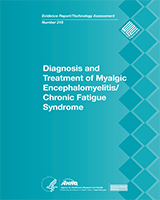NCBI Bookshelf. A service of the National Library of Medicine, National Institutes of Health.
Beth Smith ME, Nelson HD, Haney E, et al. Diagnosis and Treatment of Myalgic Encephalomyelitis/Chronic Fatigue Syndrome. Rockville (MD): Agency for Healthcare Research and Quality (US); 2014 Dec. (Evidence Reports/Technology Assessments, No. 219.)
This publication is provided for historical reference only and the information may be out of date.
Randomized Controlled Trials
Criteria
- Initial assembly of comparable groups:
- adequate randomization, including first concealment and whether potential confounders were distributed equally among groups
- Maintenance of comparable groups (includes attrition, cross-overs, adherence, contamination)
- Important differential loss to followup or overall high loss to followup
- Measurements: equal, reliable, and valid (includes masking of outcome assessment)
- Clear definition of interventions
- Important outcomes considered
- Analysis: intention-to-treat analysis.
Definition of ratings based on above criteria
| Good: | Meets all criteria: comparable groups are assembled initially and maintained throughout the study (followup at least 80%); reliable and valid measurement instruments are used and applied equally to the groups; interventions are spelled out clearly; important outcomes are considered; and intention-to-treat analysis is used. |
|---|---|
| Fair: | Studies will be graded “fair” if any or all of the following problems occur, without the fatal flaws noted in the “poor” category below: generally comparable groups are assembled initially but some question remains whether some (although not major) differences occurred in followup; measurement instruments are acceptable (although not the best) and generally applied equally; some but not all important outcomes are considered; and intention-to-treat analysis is done for randmised, controlled trials. |
| Poor: | Studies will be graded “poor” if any of the following fatal flaws exists: groups assembled initially are not close to being comparable or maintained throughout the study; unreliable or invalid measurement instruments are used or not applied at all equally among groups (including not masking outcome assessment); and intention-to-treat is lacking. |
Diagnostic/Concordance Studies
Criteria
- Test applied to an appropriate spectrum of patients (with and without disease/condition), avoiding case-control design
- Population tested was consecutive or random
- Clear eligibility criteria described and rigorous assessment of disease/condition
- Attrition reported and minimal loss to followup
- Test is adequately described and reproducible
- Test was validated in a second population group
- Test is an available standard case definition
- Diagnostic test is applied to all patients
- Blinding of outcome assessors to the reference standard
Definition of ratings based on above criteria
| Good: | Evaluates relevant available screening test; uses a credible reference standard; interprets reference standard independently of screening test; reliability of test assessed; has few or handles indeterminate results in a reasonable manner; includes large number (more than 500) broad-spectrum patients with and without disease; study attempts to enroll a random or consecutive sample of patients who meet inclusion criteria screening cutoffs pre-stated. |
|---|---|
| Fair: | Evaluates relevant available screening test; uses reasonable although not best standard; interprets reference standard independent of screening test; moderate sample size (100 to 500 subjects) and a “medium” spectrum of patients (i.e. applicable to many settings where the diagnostic test would be applied). |
| Poor: | Has important limitation such as: uses inappropriate reference standard; screening test improperly administered; biased ascertainment of reference standard; small sample size (<100) of very narrow selected spectrum of patients (components of study not well described). |
Sources: USPSTF Procedure Manual1, AHRQ Methods Guide,2 and AHRQ Methods Guide for Medical Test Reviews3
References
- 1.
- U.S. Preventive Services Task Force. US Preventive Services Task Force Procedure Manual. Rockville (MD): Jul, 2008. [Accessed March 21, 2014]. AHRQ Publication No. 08-05118-EF. Available at: www
.uspreventiveservicestaskforce .org/uspstf08 /methods/procmanual.htm. - 2.
- Methods Guide for Effectiveness and Comparative Effectiveness Reviews. Rockville (MD): Agency for Healthcare Research and Quality; Jan, 2014. AHRQ Publication No. 10(13)-EHC063-EF. Available at: www
.effectivehealthcare.ahrq.gov. - 3.
- Methods Guide for Medical Test Reviews. Rockville, MD: Agency for Healthcare Research and Quality; Jun, 2012. AHRQ Publication No. 12-EC017. www
.effectivehealthcare .ahrq.gov/reports/final.cfm. Also published as a special supplement to the Journal of General Internal Medicine, July 2012.
- Quality Rating Criteria - Diagnosis and Treatment of Myalgic Encephalomyelitis/C...Quality Rating Criteria - Diagnosis and Treatment of Myalgic Encephalomyelitis/Chronic Fatigue Syndrome
Your browsing activity is empty.
Activity recording is turned off.
See more...
